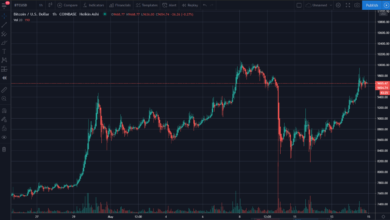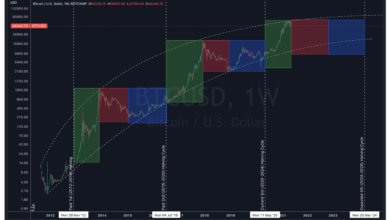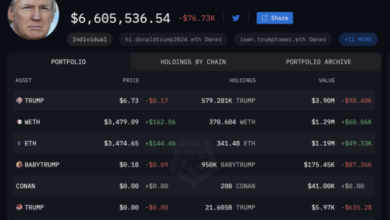
Digital Finance A Money Launderers Dream?
Digital finance is a money launderers dream argues an author – Digital finance is a money launderer’s dream, argues an author. This isn’t just a sensationalist headline; it’s a chilling reality highlighted by the increasing anonymity offered by cryptocurrencies and decentralized finance (DeFi). Think about it: instant, borderless transactions, often untraceable, and operating outside traditional banking regulations. This creates a perfect storm for those looking to obscure the origins of illicit funds.
This post delves into the dark side of digital finance, exploring how it’s being exploited and what we can do to fight back.
The ease with which money can be moved and hidden within the digital realm presents a significant challenge to law enforcement and regulatory bodies. From the complexities of cryptocurrency transactions to the relative lack of oversight in some DeFi platforms, the opportunities for money laundering are vast. We’ll examine specific examples, regulatory responses (and their limitations), and the crucial role individuals and businesses play in preventing this increasingly sophisticated form of financial crime.
The Allure of Digital Finance for Money Launderers
The rise of digital finance has created a parallel financial system, one that offers unprecedented opportunities for legitimate transactions but also presents significant challenges in the fight against money laundering. The speed, anonymity, and global reach of digital platforms are particularly attractive to those seeking to obscure the origins and destination of illicit funds. This section will explore the specific features of digital finance that make it a haven for money launderers.The Anonymity Offered by Digital Finance PlatformsDigital finance platforms, particularly cryptocurrencies and decentralized finance (DeFi) protocols, often offer a degree of anonymity that traditional banking systems lack.
Crypto transactions, for example, are recorded on a public blockchain, but the identities of the users are often masked through the use of pseudonymous addresses. This makes it difficult to trace the flow of funds and identify the individuals involved in suspicious transactions. Furthermore, many DeFi platforms operate with minimal or no know-your-customer (KYC) or anti-money laundering (AML) compliance, creating a regulatory grey area ripe for exploitation.
This contrasts sharply with traditional banking, where stringent KYC/AML regulations require identification and verification of all customers.Challenges Posed by Cryptocurrency and Decentralized Finance (DeFi) to Anti-Money Laundering EffortsCryptocurrencies and DeFi present unique challenges to AML efforts. The decentralized and pseudonymous nature of these systems makes it difficult for law enforcement and regulatory bodies to track illicit funds. The global reach of these platforms also complicates international cooperation in combating money laundering.
Moreover, the constantly evolving technological landscape of DeFi, with new protocols and tokens emerging regularly, makes it difficult for regulators to keep pace and implement effective AML measures. The lack of central oversight and the inherent complexity of many DeFi protocols further exacerbate these challenges.Comparing Traditional Banking Systems and Digital Finance Platforms in Terms of Money Laundering VulnerabilityTraditional banking systems, while not immune to money laundering, are subject to more stringent regulations and oversight.
KYC/AML compliance is mandatory, and banks are required to report suspicious activity. The centralized nature of these systems also makes it easier to trace the flow of funds. In contrast, digital finance platforms, particularly those operating in less regulated jurisdictions, offer a higher degree of anonymity and are more difficult to monitor. The lack of centralized control and the global reach of these platforms make it challenging to enforce AML regulations effectively.
So, this author’s arguing that digital finance is a money launderer’s dream – easy to hide transactions, right? But the lack of robust regulation highlights a bigger issue; it’s a perfect example of how technology can exacerbate existing inequalities. Check out this article on why the ai revolution is leaving africa behind to see how a similar lack of access impacts development.
Essentially, while some exploit digital finance for illicit gains, others are left behind, making the whole thing a really twisted picture of progress. It reinforces the author’s point about digital finance being ripe for abuse.
However, it’s crucial to note that even traditional banking systems can be vulnerable to sophisticated money laundering schemes.Digital Finance Methods and Their Respective AML RisksThe following table compares different digital finance methods and their associated AML risks:
| Digital Finance Method | Anonymity Level | AML Risk | Regulatory Oversight |
|---|---|---|---|
| Cryptocurrencies (e.g., Bitcoin) | High (pseudonymous transactions) | High | Varying (increasingly regulated in some jurisdictions) |
| Mobile Payments (e.g., PayPal, Venmo) | Medium (KYC/AML measures often in place) | Medium | Generally high in developed countries |
| Online Banking | Low (strict KYC/AML regulations) | Low | High |
| Decentralized Finance (DeFi) | High (often pseudonymous and lacks centralized control) | High | Low to emerging |
Methods of Money Laundering in the Digital Age

The anonymity and speed offered by digital finance platforms create fertile ground for money laundering. Criminals exploit the complexities of these systems to obscure the origins of illicit funds and integrate them into the legitimate economy. This section explores the specific techniques used and provides examples of successful – and often devastating – money laundering schemes.The ease of transferring funds across borders, coupled with the relative lack of stringent regulatory oversight in some jurisdictions, makes digital finance a particularly attractive tool for money launderers.
They employ sophisticated layering and integration techniques to make tracing the money’s path incredibly difficult, if not impossible, for law enforcement.
Layering and Integration Techniques in Digital Finance
Layering involves creating a complex web of transactions to obscure the original source of the money. This might involve moving funds through multiple accounts in different jurisdictions, using a variety of payment methods, including cryptocurrency exchanges, online payment processors, and peer-to-peer (P2P) transfer services. Integration is the final stage, where the laundered money is introduced back into the legitimate financial system.
This often involves purchasing assets like real estate or businesses, or investing in legitimate ventures.For example, a criminal might deposit illicit cash into a series of seemingly unrelated online accounts, then transfer smaller amounts between them, using various digital wallets and cryptocurrencies. The money could then be used to purchase gift cards, which are then resold for cash, effectively obscuring the original source.
Finally, the “cleaned” money might be used to invest in a legitimate business, making it almost impossible to trace back to the original crime.
Case Studies of Successful Money Laundering Schemes
Several high-profile cases highlight the effectiveness of money laundering through digital platforms. One example involves a network using a series of shell companies and cryptocurrency exchanges to launder millions of dollars derived from drug trafficking. The complexity of the transactions, involving multiple jurisdictions and various digital currencies, made tracing the funds extremely challenging. Another example involves a sophisticated scheme using P2P platforms to transfer illicit funds, making use of the anonymity offered by these systems.
The perpetrators were able to successfully integrate the laundered money into the legitimate financial system through a series of seemingly legitimate investments. These cases demonstrate the sophisticated techniques employed by criminals and the challenges faced by law enforcement in combating this type of crime.
A Typical Money Laundering Process in Digital Finance
The following flowchart illustrates a typical money laundering process within a digital finance ecosystem:[Description of Flowchart: The flowchart would begin with “Illicit Funds,” branching to “Placement” (depositing funds into digital accounts), then “Layering” (multiple transactions through various platforms, including cryptocurrency exchanges, online payment processors, and P2P transfers), and finally “Integration” (investing in legitimate assets or businesses). Each stage would have further sub-branches illustrating the specific methods used.
The final outcome would be “Cleaned Money.”]
The Role of Virtual Asset Service Providers (VASPs)
Virtual Asset Service Providers (VASPs), including cryptocurrency exchanges and custodians, play a crucial role in facilitating money laundering activities. Their services provide a convenient and often anonymous way to move and exchange digital assets. The lack of robust Know Your Customer (KYC) and Anti-Money Laundering (AML) procedures in some VASPs creates vulnerabilities that criminals exploit. The decentralized nature of some cryptocurrencies further complicates efforts to track and trace illicit transactions.
Therefore, stringent regulatory oversight and effective KYC/AML compliance measures are essential to mitigate the risks associated with VASPs and prevent their misuse in money laundering schemes.
So, this author makes a compelling point about digital finance being a money launderer’s dream – the anonymity is terrifying! It got me thinking about how much harder it is to track these crimes, which is why I was so fascinated to read about how true crime fans are banding together online to try to solve cases – maybe they could turn their attention to this?
The scale of the problem with digital finance is seriously worrying.
Regulatory and Technological Responses: Digital Finance Is A Money Launderers Dream Argues An Author
The ease with which digital finance facilitates money laundering presents a significant challenge to regulators and law enforcement worldwide. Existing frameworks, while robust in some areas, struggle to keep pace with the rapid innovation and global reach of digital financial services. This necessitates a multi-pronged approach combining strengthened regulatory oversight with the deployment of advanced technological solutions.The current regulatory landscape is a patchwork of national and international initiatives.
Key frameworks include the Financial Action Task Force (FATF) Recommendations, which provide a global standard for combating money laundering and terrorist financing. These recommendations are implemented through national laws and regulations, often requiring financial institutions to conduct Know Your Customer (KYC) and Anti-Money Laundering (AML) checks. However, the effectiveness of these regulations varies considerably across jurisdictions, creating loopholes that criminals can exploit.
Furthermore, the decentralized and borderless nature of many digital finance platforms makes enforcement challenging.
An author recently argued that digital finance is a money launderer’s dream, offering unprecedented anonymity. This is especially concerning given the challenges facing Bangladesh’s new ruler, who, as highlighted in this insightful article, bangladeshs new ruler is in a race against time , to tackle corruption and stabilize the economy. The ease of illicit transactions in the digital realm only exacerbates the existing problems, making the fight against money laundering even more critical.
Limitations of Existing AML Regulations
Existing AML regulations face several significant limitations in the context of digital finance. The speed and anonymity afforded by cryptocurrencies and other digital assets make it difficult to track transactions effectively. The global nature of digital platforms means that regulatory bodies often lack the jurisdiction to investigate and prosecute offenders. Furthermore, the sheer volume of transactions occurring in the digital space overwhelms traditional monitoring systems, making it difficult to identify suspicious activity.
Finally, the constant evolution of new technologies and financial instruments necessitates continuous adaptation of regulatory frameworks, which often lags behind technological advancements. For example, the use of decentralized finance (DeFi) protocols, with their inherent lack of centralized control, poses a particularly significant challenge to traditional regulatory approaches.
Technological Solutions for Enhanced AML Compliance
Technological advancements offer promising tools for enhancing AML compliance in digital finance. Blockchain analysis, for example, allows investigators to trace the movement of cryptocurrencies and identify patterns of suspicious activity. This technology leverages the inherent transparency of blockchain technology to reconstruct transaction histories and link them to individuals or entities. AI-powered fraud detection systems can analyze vast amounts of data to identify anomalies and predict potential money laundering attempts.
These systems can learn from past patterns of suspicious activity and adapt to new techniques employed by criminals. Furthermore, the use of distributed ledger technology (DLT) itself, beyond blockchain, can potentially improve transparency and traceability of transactions within digital finance systems, providing a foundation for more effective monitoring and control.
Potential Improvements to Regulatory Frameworks and Technological Solutions
The effectiveness of combating money laundering in digital finance hinges on a coordinated effort involving strengthened regulatory frameworks and the strategic deployment of advanced technologies. Improvements should focus on:
- Harmonizing international AML regulations to create a more consistent and effective global framework.
- Developing more robust KYC and AML procedures specifically tailored to the unique characteristics of digital finance platforms.
- Investing in advanced technology such as blockchain analysis and AI-powered fraud detection systems.
- Promoting greater collaboration between regulatory bodies, financial institutions, and technology providers.
- Establishing clear legal frameworks for the regulation of decentralized finance (DeFi) platforms.
- Enhancing international cooperation to track and prosecute offenders involved in cross-border money laundering schemes.
- Creating a regulatory sandbox environment for testing and evaluating new technologies and AML solutions.
- Developing educational programs to raise awareness of money laundering risks and best practices among financial professionals.
The Role of Individuals and Businesses

The ease and speed of digital finance transactions present a double-edged sword. While offering unprecedented convenience, they also create fertile ground for money laundering activities. Understanding the roles and responsibilities of both individuals and businesses is crucial in mitigating this risk and maintaining the integrity of the financial system. This requires a proactive approach from all stakeholders, fostering a culture of vigilance and responsible financial behavior.Individuals play a vital, albeit often overlooked, role in preventing money laundering.
Their actions, whether knowingly or unknowingly, can significantly impact the success of illicit activities. Businesses, on the other hand, bear a heavier legal and ethical burden, owing to their direct involvement in processing transactions. Effective collaboration between these two groups is paramount.
Individual Responsibilities in Preventing Money Laundering
Individuals should be aware of the red flags associated with potentially illicit activities. This includes being cautious about unsolicited investment opportunities promising unusually high returns, avoiding transactions through untraceable digital currencies without proper due diligence, and reporting suspicious activities to the appropriate authorities. Understanding the basic principles of AML compliance, even at a personal level, empowers individuals to make more informed financial decisions and contributes to a safer financial ecosystem.
For example, if someone is offered a suspiciously lucrative investment opportunity online, they should independently verify the legitimacy of the offer before committing any funds.
Business Due Diligence Measures to Mitigate Money Laundering Risks
Businesses must implement robust KYC (Know Your Customer) and AML (Anti-Money Laundering) procedures. This involves verifying the identity of customers, monitoring transactions for unusual patterns, and maintaining detailed records of all financial activities. Failing to implement these measures can result in significant legal and financial penalties. For instance, a bank failing to properly verify the identity of a customer who subsequently uses their account for money laundering could face hefty fines and reputational damage.
Effective due diligence also includes training employees to recognize suspicious activity and establishing clear reporting procedures.
Identifying and Reporting Suspicious Transactions
Identifying suspicious transactions requires a multifaceted approach. Businesses should utilize transaction monitoring systems to flag unusual patterns, such as large cash deposits, frequent international transfers to high-risk jurisdictions, or transactions that lack a clear economic purpose. These systems often analyze transaction data against predefined risk parameters, alerting compliance officers to potential red flags. Once a suspicious transaction is identified, it should be reported to the relevant financial intelligence unit (FIU) according to established procedures.
For example, a casino noticing unusually large and frequent cash transactions from a single individual might trigger an internal investigation and subsequent reporting to the relevant authorities.
Implementing Robust KYC and AML Procedures
Robust KYC and AML procedures are the cornerstone of preventing money laundering through digital finance platforms. These procedures should be comprehensive, encompassing identity verification, ongoing monitoring of customer activity, and risk-based approaches that tailor due diligence measures to the specific risk profile of each customer. For example, a higher level of scrutiny might be applied to customers from high-risk jurisdictions or those involved in high-value transactions.
Regular audits and updates to KYC/AML programs are also crucial to ensure they remain effective against evolving money laundering techniques. A bank employing a layered approach to KYC, combining automated checks with manual reviews of high-risk profiles, significantly reduces its vulnerability to money laundering schemes.
The Future of Digital Finance and Money Laundering

The rapid expansion of digital finance presents both incredible opportunities and significant challenges. While it offers increased efficiency and financial inclusion, it also creates fertile ground for sophisticated money laundering schemes. Understanding how emerging technologies will shape this landscape is crucial for developing effective countermeasures. The future of the fight against financial crime hinges on anticipating and adapting to the innovative methods employed by those seeking to exploit the anonymity and speed offered by digital systems.The impact of emerging technologies, particularly Central Bank Digital Currencies (CBDCs), on money laundering is a complex issue.
While CBDCs offer the potential for increased transparency and traceability due to their centralized nature, their very design also presents new vulnerabilities.
CBDCs and Money Laundering: A Double-Edged Sword
The introduction of CBDCs presents a double-edged sword in the fight against money laundering. On one hand, the inherent traceability of transactions on a centralized ledger could significantly hinder anonymous transactions, a cornerstone of money laundering operations. Authorities could potentially track the flow of funds in real-time, making it easier to identify suspicious activities and freeze illicit assets. On the other hand, the potential for sophisticated techniques to obfuscate transactions, such as using mixers or employing multiple accounts, remains a significant concern.
Furthermore, the scale and speed of transactions facilitated by CBDCs could overwhelm existing monitoring systems, creating opportunities for launderers to exploit gaps in surveillance. The success of CBDCs in combating money laundering will depend heavily on the design and implementation of robust anti-money laundering (AML) and know-your-customer (KYC) protocols integrated directly into the CBDC system.
Challenges and Opportunities in Global Digital Finance Adoption
The increasing adoption of digital finance globally presents both significant challenges and opportunities. The challenge lies in the rapid evolution of technology, outpacing the development and implementation of effective regulatory frameworks. This creates a regulatory gap that money launderers are quick to exploit. Opportunities arise from the potential for enhanced international cooperation and the development of innovative technological solutions.
Real-time transaction monitoring systems, advanced data analytics, and artificial intelligence (AI) can play a significant role in identifying and preventing money laundering activities. However, the effective deployment of these technologies requires substantial investment and international collaboration.
A Hypothetical Future Money Laundering Scheme
Imagine a future where a sophisticated criminal organization leverages a decentralized finance (DeFi) platform and a CBDC to launder funds. They utilize a complex network of smart contracts on the DeFi platform to obscure the origin of funds. These contracts automatically transfer funds between numerous accounts, using decentralized exchanges to further obfuscate the trail. Simultaneously, they use the CBDC’s programmability to create seemingly legitimate transactions, using micro-transactions to break down large sums of illicit money into smaller, less suspicious amounts.
The anonymity provided by the DeFi platform combined with the speed and scale of the CBDC transactions creates a near-impossible-to-trace money laundering operation. This scenario highlights the need for proactive regulatory measures and international cooperation to prevent such sophisticated schemes from becoming a reality.
International Cooperation in Combating Cross-Border Money Laundering, Digital finance is a money launderers dream argues an author
Effective international cooperation and information sharing are paramount to combating cross-border money laundering in digital finance. The speed and borderless nature of digital transactions require a coordinated global response. This involves sharing information between financial intelligence units (FIUs), law enforcement agencies, and regulatory bodies across different jurisdictions. Strengthening international legal frameworks and promoting the adoption of consistent AML/KYC standards are crucial steps.
Enhanced collaboration through platforms like the Egmont Group can facilitate the timely exchange of information, allowing authorities to track illicit funds across borders and disrupt criminal networks. The establishment of international standards for data privacy and security while ensuring effective information sharing is a key challenge that needs to be addressed.
The rise of digital finance presents both incredible opportunities and significant risks. While offering unparalleled convenience and financial inclusion, its inherent anonymity also provides fertile ground for money laundering. Combating this requires a multi-pronged approach: strengthening regulatory frameworks, leveraging cutting-edge technology like blockchain analysis and AI, and fostering greater international cooperation. Ultimately, the responsibility lies with all of us – individuals, businesses, and governments – to ensure the integrity of the digital financial system.
Ignoring this issue is simply not an option; the future of finance depends on it.






